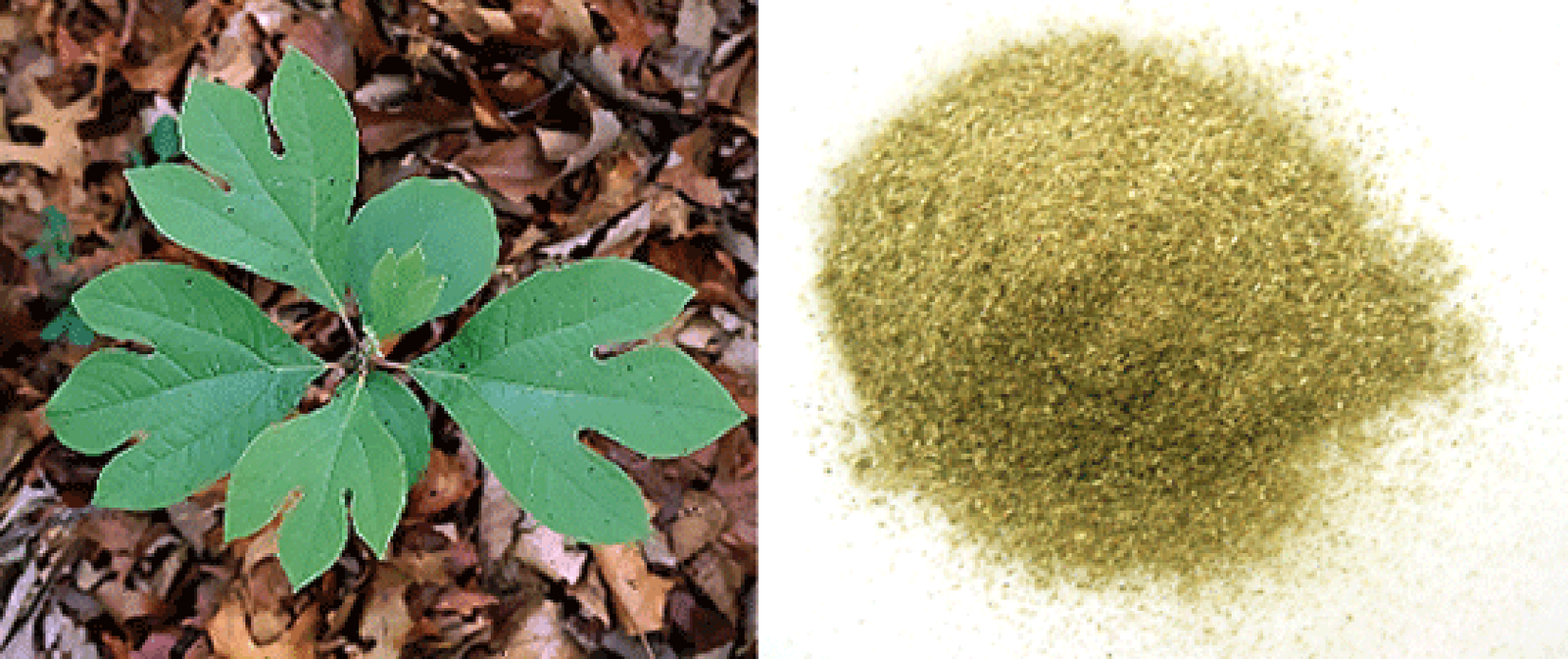 Fresh sassafras
Sassafras
albidum leaves
and powdered dried
sassafras..
Fresh sassafras
Sassafras
albidum leaves
and powdered dried
sassafras..
Welcome to the summary page for FabulousFusionFood's Herb guide to Sassafras along with all the Sassafras containing recipes presented on this site, with 2 recipes in total.
e This is a continuation of an entire series of pages that will, I hope, allow my visitors to better navigate this site. As well as displaying recipes by name, country and region of origin I am now planning a whole series of pages where recipes can be located by meal type and main ingredient. This page gives a listing of all the Cornish recipes added to this site.
These recipes, all contain Sassafras as a major herb flavouring.
Sassafras, Sassafras albidum or Sassafras tzumu (also known as White Sassafras, Red Sassafras and Silky Sassafras) are two species of deciduous trees belonging to the Lauraceae (laurel) family. The trees are native to North America and eastern Asia and grow from 15–35m tall with a trunk that ranges from 70 to 150 cm in diameter. Sassafras is distinguished by having three distinct leaf types borne on the same branch: unlobed oval, bilobed and trilobed (as most of the leaves in the image are). Young leaves produce a scent very similar to lemons when crushed. The young leaves are also mucilaginous in nature and for this reason are used to thicken sauces and soups.
The dried and powdered leaves of sassafras is known as filé powder which can either be green (from the green leaves) or black (when made from the red autumnal foliage of Sassafras). It is a key ingredient in Cajun, Creole and other Louisiana-based cuisines. An example being filé gumbo. Filé powder is also a critical ingredient in authentic Cajun blackening sauces. Though generally sold as a spice (it is said that Sassafras is the only spice originating from North America) filé powder is actually a herb as it derives from the leaves of the Sassafras tree.
Sassafras leaves have only a small quantity of essential oil (typically 0.4%), the main component of which is safrol (safrole) and with camphor, α-pinene, citral and phellandrene. It should be noted that, in rodents, safrol has been shown to be a potent hepatotoxin and hepatocarcinogen. However, the levels in the leaves (and especially in dried filé powder are generally believed to be harmless at culinary levels).
The name sassafras is derived from the Latin saxum fragans (probably by way of Spanish) and literally means 'stone breaker'. This refers to the plant's early use against kidney stones. Whilst it is true that sassafras leaves are do have diuretic properties, they are not used for this purpose today.
e This is a continuation of an entire series of pages that will, I hope, allow my visitors to better navigate this site. As well as displaying recipes by name, country and region of origin I am now planning a whole series of pages where recipes can be located by meal type and main ingredient. This page gives a listing of all the Cornish recipes added to this site.
These recipes, all contain Sassafras as a major herb flavouring.
Sassafras, Sassafras albidum or Sassafras tzumu (also known as White Sassafras, Red Sassafras and Silky Sassafras) are two species of deciduous trees belonging to the Lauraceae (laurel) family. The trees are native to North America and eastern Asia and grow from 15–35m tall with a trunk that ranges from 70 to 150 cm in diameter. Sassafras is distinguished by having three distinct leaf types borne on the same branch: unlobed oval, bilobed and trilobed (as most of the leaves in the image are). Young leaves produce a scent very similar to lemons when crushed. The young leaves are also mucilaginous in nature and for this reason are used to thicken sauces and soups.
The dried and powdered leaves of sassafras is known as filé powder which can either be green (from the green leaves) or black (when made from the red autumnal foliage of Sassafras). It is a key ingredient in Cajun, Creole and other Louisiana-based cuisines. An example being filé gumbo. Filé powder is also a critical ingredient in authentic Cajun blackening sauces. Though generally sold as a spice (it is said that Sassafras is the only spice originating from North America) filé powder is actually a herb as it derives from the leaves of the Sassafras tree.
Sassafras leaves have only a small quantity of essential oil (typically 0.4%), the main component of which is safrol (safrole) and with camphor, α-pinene, citral and phellandrene. It should be noted that, in rodents, safrol has been shown to be a potent hepatotoxin and hepatocarcinogen. However, the levels in the leaves (and especially in dried filé powder are generally believed to be harmless at culinary levels).
The name sassafras is derived from the Latin saxum fragans (probably by way of Spanish) and literally means 'stone breaker'. This refers to the plant's early use against kidney stones. Whilst it is true that sassafras leaves are do have diuretic properties, they are not used for this purpose today.
The alphabetical list of all Sassafras recipes on this site follows, (limited to 100 recipes per page). There are 2 recipes in total:
Page 1 of 1
| Cajun Blackening Spices Origin: Cajun | Chinese Barbecue Sauce Origin: Fusion |
Page 1 of 1